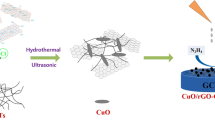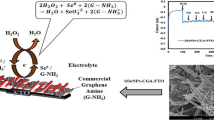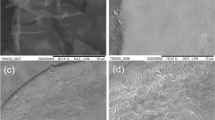Abstract
Co3O4 is often used to detect H2O2. However, there are many problems such as low sensitivity and the long detection time when detecting H2O2 in various cobalt oxide composites. Therefore, it is a great challenge to develop different morphologies of the Co3O4 electrode to improve the detection performances of H2O2 effectively. In this paper, we had successfully prepared a novel Co3O4/reduced graphene oxide/carbon cloth (Co3O4/rGO/CC) composite. We used a simple template method. Co3O4 nanosheets with a diameter of about 47.7 nm were obtained by using graphene oxide as a template. Then, CC was used as a three-dimensional conductive support material. CC can inhibit the agglomeration of rGO to increase specific surface area and to enhance the conductivity of Co3O4. In this study, the electrochemical performances of the Co3O4/rGO/CC electrode were tested by the electrochemical workstation. The trigger response of the modified electrode was reduced by 0.067% and the relative standard deviation was 0.013% after 30 consecutive tests. The range of linearity was 0.387–63.523 mM. Besides, this electrode has the limit of detection (0.022 μM) and a higher sensitivity (0.9683 mA mM−1 cm−2). It indicated that the electrode has excellent electrochemical sensing performance and high stability. These excellent performances are mainly due to the synergistic effect of Co3O4 nanosheets, rGO, and CC.












Similar content being viewed by others
References
Asghar A, Raman A, Daud W (2015) Advanced oxidation processes for in situ production of hydrogen peroxide/hydroxyl radical for textile wastewater treatment: a review. J Clean Prod 87:826–838
Back KH, Ha JW, Kang DH (2014) Effect of hydrogen peroxide vapor treatment for inactivating salmonella typhimurium, escherichia coli O157:H7 and listeria monocytogenes on organic fresh lettuce. Food Control 44:78–85
Moretro T, Fanebust H, Fagerlund A, Langsrud S (2019) Whole room disinfection with hydrogen peroxide mist to control Listeria monocytogenes in food industry related environments. Int J Food Microbiol 292:118–125
Vilema-Enriquez G, Arroyo A, Grijalva M, Amador-Zafra R, Camacho J (2016) Molecular and cellular effects of hydrogen peroxide on human lung cancer cells: potential therapeutic implications. Oxid Med Cell Longev 2016:1–12
Yang SL, Li G, Wang GF, Zhao JH, Hu MF, Qu LB (2015) A novel nonenzymatic H2O2 sensor based on cobalt hexacyanoferrate nanoparticles and graphene composite modified electrode. Sens Actuators B Chem 208:593–599
Sun YJ, Luo MC, Meng XX, Xiang J, Wang L, Ren QS, Guo SJ (2017) Graphene/intermetallic PtPb nanoplates composites for boosting electrochemical detection of H2O2 released from cells. Anal Chem 89:3761–3767
Fang KC, Chu CH, Hsu CP, Kang YW, Fang JY, Hsu CH, Huang YF, Chen CC et al (2014) A novel ultra-low detection limit hydrogen peroxide sensor based on horseradish peroxidase immobilized polyaniline film. ECS Trans 64:45–50
Ebrahimi F, Viell J, Mitsos A, Brandhorst M (2017) In-line monitoring of hydrogen peroxide in two-phase reactions using Raman spectroscopy. AIChE J 63:3994–4002
Olenin AY, Olenina EG (2017) Spectrophotometric nonenzymatic determination of hydrogen peroxide using silver nanoparticles. J Anal Chem 72:234–238
Fernandes KF, Lima CS, Lopes FM, Collins CH (2005) Hydrogen peroxide detection system consisting of chemically immobilised peroxidase and spectrometer. Process Biochem 40:3441–3445
Chen ZH, Tan Y, Xu KF, Zhang L, Qiu B, Guo LH, Lin ZY, Chen GN (2016) Stimulus-response mesoporous silica nanoparticle-based chemiluminescence biosensor for cocaine determination. Biosens Bioelectron 75:8–14
Zhang RZ, Chen W (2017) Recent advances in graphene-based nanomaterials for fabricating electrochemical hydrogen peroxide sensors. Biosens Bioelectron 89:249–268
Zhang XM, Li KZ, Li HJ, Lu JH, Fu QG, Jia Y, Li W (2015) Electrochemical sensing of ethylenediamine based on cuprous oxide/graphene hybrid structures. J Mater Sci 50:4288–4299. https://doi.org/10.1007/s10853-015-8981-5
Dou YH, Liao T, Ma ZQ, Tian DL, Liu QN, Xiao F, Sun ZQ, Kim JH et al (2016) Graphene-like holey Co3O4 nanosheets as a highly efficient catalyst for oxygen evolution reaction. Nano Energy 30:267–275
Cheng C, Zhou G, Du J, Zhang HM, Guo D, Li QH, Wei WF, Chen LB (2014) Hierarchical porous Co3O4 nanosheet arrays directly grown on carbon cloth by an electrochemical route for high performance Li-ion batteries. New J Chem 38:2250–2253
Jiang R, Jia LH, Guo XF, Zhao ZL, Du JP, Wang X, Wang P, Xing FL (2019) Dimethyl sulfoxide-assisted hydrothermal synthesis of Co3O4-based nanorods for selective and sensitive diethyl ether sensing. Sens Actuators B Chem 290:275–284
Yin HY, Zhu JJ, Chen JL, Gong JY, Nie QL (2018) PEG-templated assembling of Co3O4 nanosheets with nanoparticles for enhanced sensitive non-enzymatic glucose sensing performance. J Mater Sci Mater Electron 29:17305–17313
Wang L, Yuan YF, Zhang T, Chen Q, Guo SY (2019) Co3O4 hollow nanospheres/carbon-as bled mesoporous polyhedron with internal bubbles encapsulating TiO2 nanosphere for high-performance lithium ion batteries. Nanotechnology. https://doi.org/10.1088/1361-6528/ab2002
Hu H, Guan BY, Xia BY, Lou XW (2015) Designed formation of Co3O4/NiCo2O4 double-shelled nanocages with enhanced pseudocapacitive and electrocatalytic properties. J Am Chem Soc 137:5590–5595
Wang XQ, Wu Q, Ma HC, Ma C, Yu ZH, Fu YH, Dong XL (2019) Fabrication of PbO2 tipped Co3O4 nanowires for efficient photoelectrochemical decolorization of dye (reactive brilliant blue KN-R) wastewater. Sol Energy Mater Sol Cells 191:381–388
Zhang HF, Lu CX, Hou H, Ma YY, Yuan SX (2019) Facile morphology-controlled synthesis of Co3O4 nanostructure on carbon cloth and their morphology-dependent pseudocapacitive performances. J Alloys Compd 797:970–977
Wu J, Zhou JH, Lin Q, Luo L, Lu QS (2019) Ternary Co3O4/NiO/reduced graphene oxide hybrid composites with improved electrochemical properties. Ceram Int 45:15394–15399
Zhu CZ, Yang GH, Li H, Du D, Lin YH (2015) Electrochemical sensors and biosensors based on nanomaterials and nanostructures. Anal Chem 87:230–249
Dinesh B, Veeramani V, Chen SM, Saraswathi R (2017) In situ electrochemical synthesis of reduced graphene oxide-cobalt oxide nanocomposite modified electrode for selective sensing of depression biomarker in the presence of ascorbic acid and dopamine. J Electroanal Chem 786:169–176
Vinodhkumar G, Ramya R, Potheher IV, Vimalan M, Peter AC (2019) Synthesis of reduced graphene oxide/Co3O4 nanocomposite electrode material for sensor application. Res Chem Intermed 45:3033–3051
Liu XD, Liu JY, Liu Q, Chen RR, Zhang HS, Yu J, Song DL, Li JQ et al (2018) Template-free synthesis of rGO decorated hollow Co3O4 nano/microspheres for ethanol gas sensor. Ceram Int 44:21091–21098
Cheng SY, Gao X, Delacruz S, Chen C, Tang ZR, Shi TL, Carraro C, Maboudian R (2019) In situ formation of metal-organic framework derived CuO polyhedrons on carbon cloth for highly sensitive non-enzymatic glucose sensing. J Mater Chem B 7:4990–4996
Zhang LJ, Zhang YY, Huang SL, Yuan YL, Li H, Jin ZY, Wu JH, Liao QF et al (2018) Co3O4/Ni-based MOFs on carbon cloth for flexible alkaline battery-supercapacitor hybrid devices and near-infrared photocatalytic hydrogen evolution. Electrochim Acta 281:189–197
Li L, Liu SX, Wang H, Yang P (2018) Application of graphene-cobalt/nickel composite-carbon cloth modified electrode in microbial fuel cell. Environ Eng Sci 35:1173–1184
Wang Q, Wu MY, Meng SJ, Zang XX, Dai ZY, Si WL, Huang W, Dong XC (2016) Hydrazine sensor based on Co3O4/rGO/carbon cloth electrochemical electrode. Adv Mater Interfaces 3:1–6
Zhang XM, Li KZ, Li HJ, Lu JH (2013) Dipotassium hydrogen phosphate as reducing agent for the efficient reduction of graphene oxide nanosheets. J Colloid Interface Sci 409:1–7
Sahu TK, Arora S, Banik A, Iyer PK, Qureshi M (2017) Efficient and rapid removal of environmental malignant arsenic(III) and industrial dyes using reusable, recoverable ternary iron oxide-ORMOSIL-Reduced Graphene Oxide Composite. ACS Sustain Chem Eng 5:5912–5921
Kong LJ, Ren ZY, Zheng NN, Du SC, Wu J, Tang JL, Fu HG (2015) Interconnected 1D Co3O4 nanowires on reduced graphene oxide for enzymeless H2O2 detection. Nano Res 8:469–480
Zhang XM, Li KZ, Li HJ, Lu JH, Fu QG, Zhang LL (2016) Hydrothermal synthesis of cobalt oxide porous nanoribbons anchored with reduced graphene oxide for hydrogen peroxide detection. J Nanopart Res 18:1–12
Yu ZY, Li HJ, Zhang XM, Liu NK, Tan WL, Zhang X, Zhang LL (2016) Facile synthesis of NiCo2O4@Polyaniline core-shell nanocomposite for sensitive determination of glucose. Biosens Bioelectron 75:161–165
Cheng Y, Feng B, Yang X, Yang P, Ding YL, Chen Y, Fei JJ (2013) Electrochemical biosensing platform based on carboxymethyl cellulose functionalized reduced graphene oxide and hemoglobin hybrid nanocomposite film. Sens Actuators B Chem 182:288–293
Zhang LL, Han GQ, Liu Y, Tang J, Tang WH (2014) Immobilizing haemoglobin on gold/graphene–chitosan nanocomposite as efficient hydrogen peroxide biosensor. Sens Actuat B Chem 197:164–171
Fan ZJ, Lin QQ, Gong PW, Liu B, Wang JQ, Yang SR (2014) A new enzymatic immobilization carrier based on graphene capsule for hydrogen peroxide biosensors. Electrochim Acta 151:186–194
Radhakrishnan S, Kim SJ (2015) An enzymatic biosensor for hydrogen peroxide based on one-pot preparation of CeO2-reduced graphene oxide nanocomposite. RSC Adv 5:12937–12943
Zhang YL, Xie JL, Xiao SX, Yang ZM, Pang PF, Bai W, Gao YT (2014) Facile and controllable synthesis of Prussian blue nanocubes on TiO2–graphene composite nanosheets for nonenzymatic detection of hydrogen peroxide. Anal Methods 6:9761–9768
Karimi MA, Banifatemeh F, Hatefi-Mehrjardi A, Tavallali H, Eshaghia Z, Deilamy-Rad G (2015) A novel rapid synthesis of Fe2O3/graphene nanocomposite using ferrate (VI) and its application as a new kind of nanocomposite modified electrode as electrochemical sensor. Mater Res Bull 70:856–864
Zhang BY, Zhang XF, Huang DK, Li SH, Yuan HL, Wang MK, Shen Y (2015) Co9S8 hollow spheres for enhanced electrochemical detection of hydrogen peroxide. Talanta 141:73–79
Liu DN, Chen T, Zhu WX, Cui L, Asiri AM, Lu Q, Sun XP (2016) Cobalt phosphide nanowires: an efficient electrocatalyst for enzymeless hydrogen peroxide detection. Nanotechnology 27:1–6
Annalakshmi M, Balasubramanian P, Chen SM, Chen TW (2019) Enzyme-free electrocatalytic sensing of hydrogen peroxide using a glassy carbon electrode modified with cobalt nanoparticle-decorated tungsten carbide. Microchim Acta. https://doi.org/10.1007/s00604-019-3377-x
Cui X, Zhao H, Li Z (2018) Hexagonal cobalt oxyhydroxide nanoflakes/reduced graphene oxide for hydrogen peroxide detection in biological samples. Anal Bioanal Chem 410:7523–7535
Acknowledgements
This work has been approved by the Natural Science Basic Research Plan in Shaanxi Province of China under Grant No. 2019JQ-427, the Doctoral Scientific Research Foundation of Shaanxi University of Science and Technology under Grant No. 2016GBJ-15, and the Special Scientific Research Plan Project of Shaanxi Provincial Education Department under Grant No. 17JK0088.
Author information
Authors and Affiliations
Corresponding author
Ethics declarations
Conflict of interest
There are no conflicts of interest to declare.
Additional information
Publisher's Note
Springer Nature remains neutral with regard to jurisdictional claims in published maps and institutional affiliations.
Electronic supplementary material
Below is the link to the electronic supplementary material.
Rights and permissions
About this article
Cite this article
Zhang, X., Mao, Z., Zhao, Y. et al. Highly sensitive electrochemical sensing platform: carbon cloth enhanced performance of Co3O4/rGO nanocomposite for detection of H2O2. J Mater Sci 55, 5445–5457 (2020). https://doi.org/10.1007/s10853-020-04393-0
Received:
Accepted:
Published:
Issue Date:
DOI: https://doi.org/10.1007/s10853-020-04393-0




